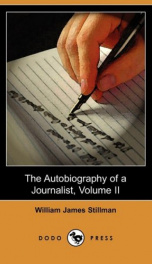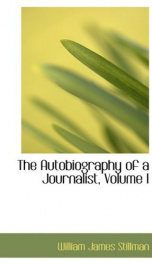Stillman William James

William James Stillman (June 1, 1828 – July 6, 1901), United States was an American painter, journalist, and photographer. Stillman was born in Schenectady, New York in 1828. His parents were Seventh Day Baptists, and his early religious training influenced him all through his life. He was sent to school in New York by his mother, who made great sacrifices that he might get an education, and he graduated from Union College of Schenectady in 1848. He studied art under Frederic E Church and early in 1850 went to England, where he made the acquaintance of Ruskin, whose Modern Painters he had devoured, was introduced to Turner, for whose works he had unbounded admiration, and fell so much under the influence of Rossetti and Millais that on his return home in the same year he speedily became known as the "American Pre-Raphaelite." In 1852 Lajos Kossuth sent him on a fool's errand to Hungary to dig up crown jewels, which had been buried secretly during the insurrection of 1848-1849. While he was awaiting a projected rising in Milan, Stillman studied art under Yvon in Paris, and then, as the rising did not take place, he returned to the United States and devoted himself to landscape painting on Upper Saranac Lake in the Adirondacks and in New York City, where he started the Crayon. It numbered Lowell, Aldrich and Charles Eliot Norton among its contributors, and when it failed for want of funds, Stillman removed to Cambridge, Massachusetts. There he passed several years, but a fit of restlessness started him off once more to England. He renewed his friendship with Ruskin, and went with him to Switzerland to paint and draw in the Alps, where he worked so assiduously that his eye-sight was affected. He then lived in Faris and was in Normandy in 1861 when the American Civil War broke out. He made more than one attempt to serve in the Northern ranks, but his health was too weak; in the same year he was appointed United States consul in Rome. In 1865 a dispute with his government led to his resignation, but immediately afterwards he was appointed to Crete, where, as an avowed champion of the Christians in the island and of Cretan independence, he was regarded with hostility both by the Moslem population and by the Turkish authorities during the subsequent Cretan uprising. In September 1868 he resigned and went to Athens, where his first wife (a daughter of David Mack of Cambridge), worn out by the excitement of life in Crete, committed suicide. He was an editor of Scribner's Magazine for a short time and then went to London, where he lived with DG Rossetti. In 1871 he married artist Marie Spartali, a daughter of the Greek consul-general Michael Spartali, although without his permission. When the insurrection of 1875 broke out in Herzegovina he went there as a correspondent of The Times, and his letters from the Balkans aroused so much interest that the British government was induced to lend its countenance to Montenegrin aspirations. In 1877-1883 he served as the correspondent of The Times at Athens; in 1886-1898 at Rome. He was a severe critic of Italian statesmen, and embroiled himself at various times with various politicians, from Crispi downwards. After his retirement he lived in Surrey, where he died on July 6, 1901. He wrote The Cretan Insurrection of 1866-1868 (1874), On the Track of Ulysses (1888), Billy and Hans (1897) and Francesco Crispi (1899). Recent critics such as Andrew Szegedy-Maszak (in Antiquity and Photography, Getty Museum, 2005) have argued that Stillman's photography, especially an album of views of the Athenian Acropolis, displayed an artistic sensibility and a genius of a higher order than the rest of his work. The first series was photographed in 1869 and privately published in 1870; Stillman rephotographed the Acropolis in 1882 and subsequently reordered the combined series in a second album. Stillman's photographs, in their daring perspectives, in their creative synthesis (inspired by Ruskinian ideas) of aesthetic feeling and a scientific/scholarly perspective on architectural form, and in their incorporation of the Greek landscape and the modern Greek context of ancient ruins, show a startlingly modern sensibility for their time, a way of seeing utterly different from the commercial photography of contemporary Greeks and foreigners, whose representations tended to cater to the set expectations of the foreign philhellenic and touristic market. This article incorporates text from the Encyclopædia Britannica, Eleventh Edition, a publication now in the public domain.
do you like this author?
What readers are saying
What do you think? Write your own comment on this book!
write a commentWhat readers are saying
What do you think? Write your own comment on this author!
write a commentBook list

The Autobiography of a Journalist, Volume II
Series:
Unknown
Year:
Unknown
Raiting:
3/5
William James Stillman (1828-1901) was an American painter, journalist, and photographer. In 1852 Lajos Kossuth sent him on a fool’s errand to Hungary to dig up crown jewels. While he was awaiting a projected rising in Milan, Stillman studied art under Yvon in Paris, and then, as the rising did not take place, he returned to the United States and devoted himself to landscape painting. He was appointed United States consul in Rome in 1861. In 1865, a dispute with his government led to his resignation, but immediately afterwards he was appointed to Crete. He was an editor of Scribner’s Magazine for a short time and then went to London. In 1877-1883 he served as the correspondent of The Times at Athens and in 1886-1898 at Rome. His works include: On the Track of Ulysses (1888) and The Autobiography of a Journalist (1901).
Show more
add to favoritesadd In favorites

The Autobiography of a Journalist, Volume I
Series:
Unknown
Year:
Unknown
Raiting:
3/5
William James Stillman (1828-1901) was an American painter, journalist, and photographer. In 1852 Lajos Kossuth sent him on a fool’s errand to Hungary to dig up crown jewels. While he was awaiting a projected rising in Milan, Stillman studied art under Yvon in Paris, and then, as the rising did not take place, he returned to the United States and devoted himself to landscape painting. He was appointed United States consul in Rome in 1861. In 1865, a dispute with his government led to his resignation, but immediately afterwards he was appointed to Crete. He was an editor of Scribner’s Magazine for a short time and then went to London. In 1877-1883 he served as the correspondent of The Times at Athens and in 1886-1898 at Rome. His works include: On the Track of Ulysses (1888) and The Autobiography of a Journalist (1901). --This text refers to an alternate Paperback edition.
Show more
add to favoritesadd In favorites
Book list

The Autobiography of a Journalist, Volume II
Series:
Unknown
Year:
Unknown
Raiting:
3/5
William James Stillman (1828-1901) was an American painter, journalist, and photographer. In 1852 Lajos Kossuth sent him on a fool’s errand to Hungary to dig up crown jewels. While he was awaiting a projected rising in Milan, Stillman studied art under Yvon in Paris, and then, as the rising did not take place, he returned to the United States and devoted himself to landscape painting. He was appointed United States consul in Rome in 1861. In 1865, a dispute with his government led to his resignation, but immediately afterwards he was appointed to Crete. He was an editor of Scribner’s Magazine for a short time and then went to London. In 1877-1883 he served as the correspondent of The Times at Athens and in 1886-1898 at Rome. His works include: On the Track of Ulysses (1888) and The Autobiography of a Journalist (1901).
Show more
add to favoritesadd In favorites

The Autobiography of a Journalist, Volume I
Series:
Unknown
Year:
Unknown
Raiting:
3/5
William James Stillman (1828-1901) was an American painter, journalist, and photographer. In 1852 Lajos Kossuth sent him on a fool’s errand to Hungary to dig up crown jewels. While he was awaiting a projected rising in Milan, Stillman studied art under Yvon in Paris, and then, as the rising did not take place, he returned to the United States and devoted himself to landscape painting. He was appointed United States consul in Rome in 1861. In 1865, a dispute with his government led to his resignation, but immediately afterwards he was appointed to Crete. He was an editor of Scribner’s Magazine for a short time and then went to London. In 1877-1883 he served as the correspondent of The Times at Athens and in 1886-1898 at Rome. His works include: On the Track of Ulysses (1888) and The Autobiography of a Journalist (1901). --This text refers to an alternate Paperback edition.
Show more
add to favoritesadd In favorites
What readers are saying
What do you think? Write your own comment on this author!
write a commentif you like Stillman William James try:
readers also enjoyed
What readers are saying
What do you think? Write your own comment on this author!
write a commentif you like Stillman William James try:
readers also enjoyed
Do you want to read a book that interests you? It’s EASY!
Create an account and send a request for reading to other users on the Webpage of the book!

